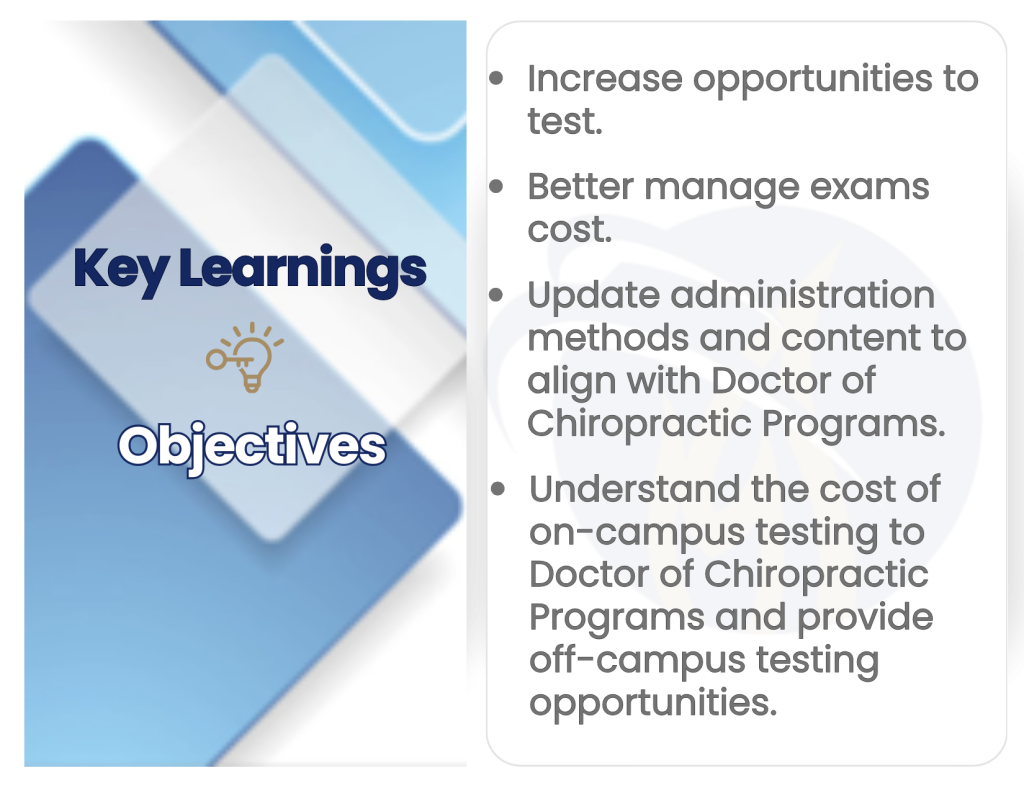
INTRODUCTION
The National Board of Chiropractic Examiners (NBCE) has actively sought feedback from all stakeholders to assess and align our vision for the future. Through these efforts, NBCE identified ‘Key Learnings’—a list of commonly requested innovations aimed at providing the highest quality exam products for the lowest possible costs while increasing testing opportunities for all students.

Following the collection of these objectives, NBCE initiated an in-depth examination of testing procedures employed at Doctor of Chiropractic Programs (DCPs). Simultaneously, we conducted assessments of various healthcare testing organizations to glean insights into prevailing best practices in pre-licensure testing. From this research, we developed multiple implementation models to discern the most fitting modifications and optimal approaches for implementation that align with our objectives, while ensuring the continued validity and reliability of our exams and minimizing the financial implications of the changes.
After identifying the solutions that best met these objectives, NBCE presented the proposed exam changes to state board members, leadership at chiropractic education institutions, and students. Following the collection and analysis of feedback from all stakeholders, the NBCE implemented changes to Parts I, II, III, and Physiotherapy in August 2024. The changes to Part IV will be implemented in 2026.

Part IV Exam
Goal:
Produce a more efficient exam that better mimics real-world patient encounters while maintaining fairness, reliability, and validity of the exam and providing more testing opportunities.
Solutions:
- Stations that mimic a complete patient encounter, from patient history to a treatment decision.
- Replacing the multiple-choice post encounter station with a station where examinees will be required to write a patient note.
- Video recording of every patient encounter station.
Planned 2026 Implementation Plan:
1. The Part IV exam will be reduced from 25 stations to eight to ten patient encounter stations with a patient note component. This decreases the number of examinees we can test in each administration of the exam from 25 to eight, requiring more administrations to test the same number of examinees.
2. Moving the exam off of Chiropractic College campuses to a centralized testing center in Greeley, Colorado. There will be an increase in travel expenses for the majority of our examinees. Currently, approximately 40% of examinees travel to a Part IV test site, either because their campus does not have a Part IV test site, or because they were not able to get their preferred testing location. For the remaining 60% of examinees that would have been able to test on their campus, we estimate that they will spend anywhere between $409 to $578 for airfare and accommodation under a centralized testing model. However, attempting to implement the proposed solutions on-campus will result in a 64% increase to annual exam expenses. This would result in an exam fee of $2,600 for the Part IV, an increase of $1,015 from the current fee. Although we understand that the increased travel expenses related to centralized testing is burdensome to the majority of our examinees, it is the most financially advantageous out of all the options considered.
Rationale:
a. Expense:
i. To implement this new exam model at our current Part IV test sites on-campus we would increase our annual expenses by 64%. If we move to a centralized testing location, we would be reducing our annual administration expenses by 6%.
ii. The cost of equipment and installation for the technological infrastructure is based on the number of patient encounter rooms equipped. By moving to a centralized testing center, we would only need to invest in equipping 16 rooms. If we rolled this out at our current on-campus test sites, we would need to purchase and install equipment in a minimum of 112 rooms.
b. Impact to campus operations:
i. The equipment and installation for on-campus testing locations would require a permanent and expanded footprint where we test.
ii. If we were to continue testing on-campus, we would need to increase the number of testing days from four per year to an average of 37 testing days at each location.
c. Benefits of a centralized testing location:
i. Increased exam opportunities. NBCE plans to offer the exam three days a week, 48 weeks out of the year. This increases our current testing capacity by 25% with no impact on campus operations.
ii. Scheduling flexibility. As the testing center in Greeley, Colorado would be dedicated solely to NBCE testing, we could quickly respond to an increase in demand by increasing testing opportunities.
iii. Staffing efficiencies. By utilizing current staff at NBCE headquarters we can minimize expenses.
iv. Increased standardization and quality. The testing center would be designed to specifications that assure the highest quality exam experience. By utilizing one space for testing, and hiring permanent staff, NBCE can ensure a more standardized testing experience.
v. Ease of future innovation. NBCE can pilot and introduce innovative exam technology (like virtual reality or force sensing tables) at one test site as opposed to rolling out this expensive technology to 14 test sites across the country.
Timeline
NBCE has planned for the first administration of the new Part IV exam in Greeley, Colorado in 2026. We will work with our academic partners and solicit feedback from examinees to ensure we have provided the appropriate amount of time to prepare for these changes.
Frequently Asked Questions
With the extensive financial burden students are currently facing, why would you consider a change that could increase the expense related to pre-licensure testing?
A: This is one of the primary reasons we are proposing a move to centralized testing. Our current administration model is financially unsustainable for many reasons, but the difficulty of managing expenses across 11 different locations is one of our top concerns. Moving to one centralized location will allow us to better manage costs, realize the financial gain from an economy of scale, and maximize current resources to hold costs steady over time.
Another factor is the introduction of video recording. This technology is essential to the future performance and quality of chiropractic pre-licensure testing. Introducing and maintaining this technology at 14 test sites is not financially feasible. To capture the benefits of this technology, we have to implement it on a much smaller scale.
With the majority of Doctor of Chiropractic Programs located on the East and West coast, have you investigated regional testing centers instead of a centralized location in Colorado?
A: Yes. NBCE investigated numerous alternatives to a centralized testing location in Greeley, Colorado. Below is a table that shows a high-level analysis of the different testing locations that were considered. This table ranks each option according to the project criteria. The option with the highest average ranking reflects the optimal solution while the lowest average ranking reflects the least optimal solution.

The additional costs of launching and running regional testing centers, in addition to the decreased standardization and quality control, make this a sub-optimal solution; especially when considering that many examinees would still have to travel to a regional testing center.
To see more frequently asked questions and answers regarding NBCE’s planned changes to be implemented in 2026 for the Part IV Exam, click here.
